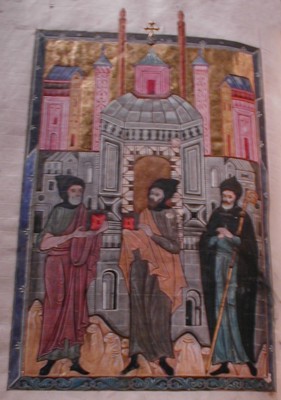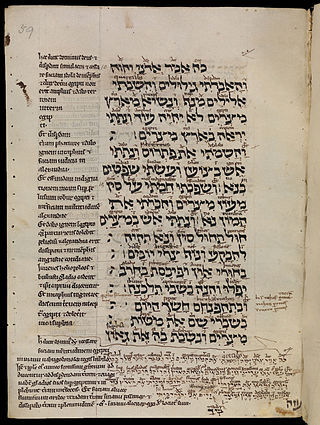The Book of Joel is a Jewish prophetic text containing a series of "divine announcements". The first line attributes authorship to "Joel the son of Pethuel". It forms part of the Book of the twelve minor prophets or the Nevi'im ("Prophets") in the Hebrew Bible, and is a book in its own right in the Christian Old Testament. In the New Testament, his prophecy of the outpouring of God's Holy Spirit upon all people was notably quoted by Saint Peter in his Pentecost sermon.

Theodoret of Cyrus or Cyrrhus was an influential theologian of the School of Antioch, biblical commentator, and Christian bishop of Cyrrhus (423–457).

Ferdinand Hitzig was a German biblical critic.
The Twelve Minor Prophets, or the Book of the Twelve, is a collection of prophetic books, written between about the 8th and 4th centuries BCE, which are in both the Jewish Tanakh and Christian Old Testament.

Gennadius I was the Patriarch of Constantinople from 458 until his death. Gennadius is known to have been a learned writer who followed the Antiochene school of literal exegesis, although few writings have been left about him. He is commemorated in the Eastern Orthodox Church on 17 November, but is not listed in the Roman Martyrology.
Cosmas of Maiuma, also called Cosmas Hagiopolites, Cosmas of Jerusalem, Cosmas the Melodist, or Cosmas the Poet, was a bishop and an important hymnographer in the East. He is venerated as a saint by the Eastern Orthodox Church and the Catholic Church.

The Ascension of Isaiah is a pseudepigraphical Judeo-Christian text. Scholarly estimates regarding the date of the Ascension of Isaiah range from 70 AD to 175 AD. Many scholars believe it to be a compilation of several texts completed by an unknown Christian scribe who claimed to be the Prophet Isaiah, while an increasing number of scholars in recent years have argued that the work is a unity by a single author that may have utilized multiple sources.
The Patrologia Graeca is an edited collection of writings by the Church Fathers and various secular writers, in the Greek language. It consists of 161 volumes produced in 1857–1866 by J.P. Migne's Imprimerie Catholique, Paris.

Evagrius Ponticus, also called Evagrius the Solitary, was a Christian monk and ascetic from Heraclea, a city on the coast of Bithynia in Asia Minor. One of the most influential theologians in the late fourth-century church, he was well known as a thinker, polished speaker, and gifted writer. He left a promising ecclesiastical career in Constantinople and traveled to Jerusalem, where in 383 AD he became a monk at the monastery of Rufinus and Melania the Elder. He then went to Egypt and spent the remaining years of his life in Nitria and Kellia, marked by years of asceticism and writing. He was a disciple of several influential contemporary church leaders, including Basil of Caesarea, Gregory of Nazianzus, and Macarius of Egypt. He was a teacher of others, including John Cassian and Palladius of Galatia.
Hesychius of Sinai was a hieromonk of Saint Catherine's Monastery on Mount Sinai, and an ascetic author of the Byzantine period in literature.
Oecumenius is the name under which are transmitted several commentaries in Greek on the New Testament. It now appears that these were not all written by the same person nor in the same period.
Jewish printers were quick to take advantages of the printing press in publishing the Hebrew Bible. While for synagogue services written scrolls were used, the printing press was very soon called into service to provide copies of the Hebrew Bible for private use. All the editions published before the Complutensian Polyglot were edited by Jews; but afterwards, and because of the increased interest excited in the Bible by the Reformation, the work was taken up by Christian scholars and printers; and the editions published by Jews after this time were largely influenced by these Christian publications. It is not possible in the present article to enumerate all the editions, whole or partial, of the Hebrew text. This account is devoted mainly to the incunabula.
In Biblical studies, a gloss or glossa is an annotation written on margins or within the text of biblical manuscripts or printed editions of the scriptures. With regard to the Hebrew texts, the glosses chiefly contained explanations of purely verbal difficulties of the text; some of these glosses are of importance for the correct reading or understanding of the original Hebrew, while nearly all have contributed to its uniform transmission since the 11th century. Later on, Christian glosses also contained scriptural commentaries; St. Jerome extensively used glosses in the process of translation of the Latin Vulgate Bible.

A catena is a form of biblical commentary, verse by verse, made up entirely of excerpts from earlier Biblical commentators, each introduced with the name of the author, and with such minor adjustments of words to allow the whole to form a continuous commentary. John Henry Newman, in his preface to Thomas Aquinas' Catena Aurea, explains that a "Catena Patrum" is "a string or series of passages selected from the writings of various Fathers, and arranged for the elucidation of some portion of Scripture, as the Psalms or the Gospels".
Isaiah 33 is the thirty-third chapter of the Book of Isaiah in the Hebrew Bible or the Old Testament of the Christian Bible. This book contains the prophecies attributed to the prophet Isaiah, and is one of the Books of the Prophets. The Jerusalem Bible groups chapters 28-35 together as a collection of "poems on Israel and Judah".
Isaiah 56 is the fifty-sixth chapter of the Book of Isaiah in the Hebrew Bible or the Old Testament of the Christian Bible. This book contains the prophecies attributed to the prophet Isaiah, and is one of the Books of the Prophets. Chapter 56 is the first chapter of the final section of the Book of Isaiah, often referred to as Trito-Isaiah.

Ezekiel 26 is the twenty-sixth chapter of the Book of Ezekiel in the Hebrew Bible or the Old Testament of the Christian Bible. This book contains the prophecies attributed to the prophet/priest Ezekiel, and is one of the Books of the Prophets.

Ezekiel 15 is the fifteenth chapter of the Book of Ezekiel in the Hebrew Bible or the Old Testament of the Christian Bible. This book contains the prophecies attributed to the prophet/priest Ezekiel, and is one of the Books of the Prophets. This chapter records a parable about the fate of the "useless" grapevine as a symbol of the nation of Israel at that time. In the New King James Version, this chapter is sub-titled "The Outcast Vine"; according to commentator Andrew Davidson, it records "the uselessness of the wood of the vine".

Jeremiah 48 is the forty-eighth chapter of the Book of Jeremiah in the Hebrew Bible or the Old Testament of the Christian Bible. This book contains prophecies attributed to the prophet Jeremiah, and is one of the Books of the Prophets. This chapter is part of a series of "oracles against foreign nations", consisting of chapters 46 to 51. In particular, chapters 46-49 focus on Judah's neighbors. This chapter contains the poetic oracles against Moab.







